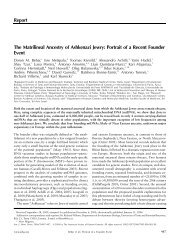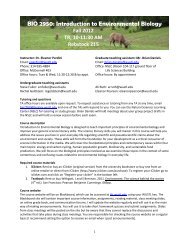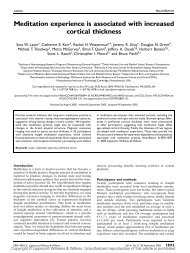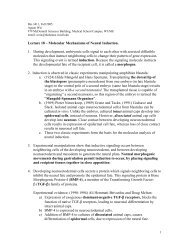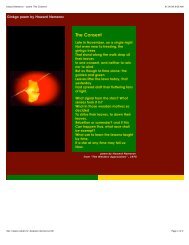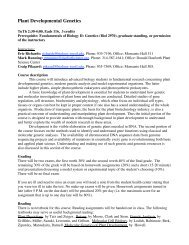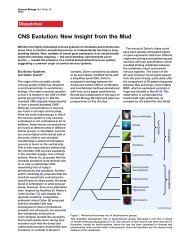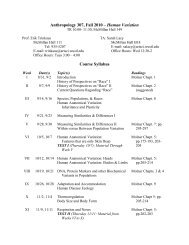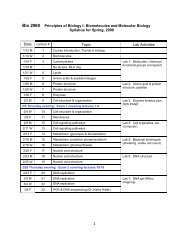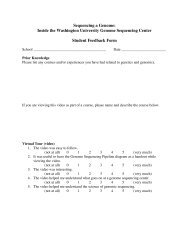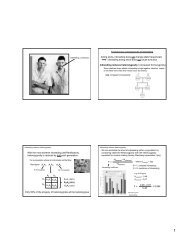P ERSPECTIVES ON DISEASEU. <strong>Bellugi</strong> <strong>et</strong> <strong>al</strong>. – Linking cognition <strong>and</strong> the brainWilliams syndrome is rare, occurring in an estimatedone in 20 000 to one in 30 000 live births. Diagnosticcharacteristics include specific faci<strong>al</strong> <strong>and</strong> physic<strong>al</strong> features:a constellation of cardiovascular difficulties,which include suprav<strong>al</strong>vular aortic stenosis (SVAS);failure to thrive in infancy; transient neonat<strong>al</strong> hyperc<strong>al</strong>cemia;delayed language <strong>and</strong> motor milestones,<strong>and</strong> abnorm<strong>al</strong> sensitivities to classes of sounds (hyperacusis).It has been recently found that in well over95% of the individu<strong>al</strong>s who have been diagnosed clinic<strong>al</strong>lywith WMS, there is a submicroscopic del<strong>et</strong>ion ofone copy of perhaps 20 contiguous genes, whichinclude the gene for elastin, among others, on chromosome7. The del<strong>et</strong>ion of one copy of elastin hasprovided a new gen<strong>et</strong>ic marker for WMS (Refs 11,12).Cognitive profile of WMSCognitive deficitsA h<strong>al</strong>lmark of WMS is the dissociation b<strong>et</strong>ween language(which is a strength in adolescents <strong>and</strong> adults)<strong>and</strong> spati<strong>al</strong> cognition (which is profoundly impaired),as shown in Fig. 1A. There are consistent cognitivedeficits in WMS: in gener<strong>al</strong>, st<strong>and</strong>ard Full Sc<strong>al</strong>e IQscores range from 40–100, with means of around 60(Refs 2,13; Fig. 1B). Many individu<strong>al</strong>s with WMS findaspects of gener<strong>al</strong> problem solving difficult; most arenot able to achieve independent living 14 <strong>and</strong> typic<strong>al</strong>lyexperience difficulty when de<strong>al</strong>ing with money or b<strong>al</strong>ancinga checkbook. However, within the context oftheir intellectu<strong>al</strong> impairments, individu<strong>al</strong>s with WMSdisplay characteristic ‘peaks’ <strong>and</strong> ‘v<strong>al</strong>leys’ in specificcognitive abilities. Complex expressive language abilitiesare relatively strong, spati<strong>al</strong> cognition is disproportionatelyimpaired (particularly at the level of glob<strong>al</strong>organization) <strong>and</strong> face-processing abilities are remarkablystrong. From studies across different populations, acharacteristic WMS cognitive profile is emerging 2,6,8,15 .Expressive language abilitiesOne striking aspect of the WMS profile is thestrength in language abilities in adolescence <strong>and</strong>adulthood, in contrast to the over<strong>al</strong>l impairment seenin cognitive abilities. Although in the earliest stages oflanguage development, children with WMS show significantdelay 16 , once language is acquired, this abilitytends to become a relative strength in their cognitiveprofile. When adolescents <strong>and</strong> adults with WMS <strong>and</strong>Down syndrome (DNS), both syndromes of ment<strong>al</strong>r<strong>et</strong>ardation that are gen<strong>et</strong>ic<strong>al</strong>ly based, are matched inage <strong>and</strong> Full Sc<strong>al</strong>e IQ, the differences in language skillsare evident at <strong>al</strong>l levels (phonologic<strong>al</strong>, lexic<strong>al</strong>, morphologic<strong>al</strong><strong>and</strong> syntactic, as well as at levels ofprosody, discourse <strong>and</strong> narrative). For example, adolescentswith WMS score significantly higher on measuresof receptive word knowledge than on measures ofgener<strong>al</strong> cognitive functioning, <strong>and</strong> perform dramatic<strong>al</strong>lyb<strong>et</strong>ter than their counterparts with DNS(Ref. 17). On a word-fluency test, which asks subjectsto name <strong>al</strong>l the anim<strong>al</strong>s they can in 60 seconds, adolescents<strong>and</strong> adults with WMS score similarly to norm<strong>al</strong>individu<strong>al</strong>s at the same ment<strong>al</strong> age. Moreover, theresponses of the WMS group might include manyatypic<strong>al</strong> examples (for example, chihuahua, ibex, condor)as well as typic<strong>al</strong> ones (Fig. 1C). As part of a basisfor their language strengths, short-term memory forspeech sounds or phonologic<strong>al</strong> working memory, aform of memory that is relevant to language learning<strong>and</strong> comprehension, is relatively preserved in theWMS population 6,18,19 . The strength in verb<strong>al</strong> memoryseen in WMS is apparent when contrasted withanother domain, that of spati<strong>al</strong> memory. Individu<strong>al</strong>swith WMS show far b<strong>et</strong>ter verb<strong>al</strong> memory than spati<strong>al</strong>memory, whereas individu<strong>al</strong>s with DNS exhibit theopposite pattern (Fig. 1D) 2,20 .In gener<strong>al</strong>, compared with age-matched <strong>and</strong> FullSc<strong>al</strong>e IQ-matched subjects with DNS, the subjects withWMS perform far b<strong>et</strong>ter on a wide vari<strong>et</strong>y of grammarprobes (reversible passives, negation, tag questions,sentence rep<strong>et</strong>ition, sentence compl<strong>et</strong>ion, sentencecorrection, condition<strong>al</strong>s, <strong>et</strong>c.; see Fig. 1E) 2,3,17 . Thus,language at <strong>al</strong>l levels in older individu<strong>al</strong>s with WMSis a remarkable strength, in light of the level of cognitivedeficits that they have gener<strong>al</strong>ly 17 . In fact, becaus<strong>et</strong>heir language abilities are often at a level that ishigher than their over<strong>al</strong>l cognitive abilities, individu<strong>al</strong>swith WMS might be perceived to be more capabl<strong>et</strong>han they re<strong>al</strong>ly are. Although the domain of languageis a strength of individu<strong>al</strong>s with WMS, there are cluesthat language might develop in somewhat differentways than in norm<strong>al</strong> children. Morphologic<strong>al</strong> errorsabate more slowly in children with WMS than in norm<strong>al</strong>children (but far more rapidly than in DNS) 21 <strong>and</strong>errors show some differences from those produced bynorm<strong>al</strong> children 6,15,22,23 . Studies are now showing thatthere are proportionately far more errors in the use ofspati<strong>al</strong> prepositions <strong>and</strong> in the use of language aboutspace by WMS individu<strong>al</strong>s than found in the norm<strong>al</strong>development (for example, when describing a pictureof an apple in a bowl during an experiment<strong>al</strong> task,WMS individu<strong>al</strong>s made errors such as ‘The apple isaround the bowl’, ‘The bowl is in the apple’ or ‘Theapple without the bowl’) 23 .There are controversi<strong>al</strong> issues raised by the researchon WMS concerning the relationship b<strong>et</strong>ween language<strong>and</strong> cognition, which are still a matter ofdebate 10,22–25 . Some researchers consider the syndrom<strong>et</strong>o be a remarkable example of the modularity of languageas a system that is separate from gener<strong>al</strong> cognitiveabilities. Others argue that as adults with WMS aresaid to function in some ways at the five- to sevenyear-oldlevel, there is a sufficient substrate of cognitiveabilities for the development of complex syntax,<strong>and</strong> that, thus, WMS does not represent a dissociationb<strong>et</strong>ween language <strong>and</strong> gener<strong>al</strong> cognitive functions.There are unresolved issues about the relationshipb<strong>et</strong>ween syntax <strong>and</strong> semantics, <strong>and</strong> about the intactnessof levels of language in WMS (Ref. 18), y<strong>et</strong>researchers agree gener<strong>al</strong>ly that language (for example,morphology <strong>and</strong> syntax) is a relative strength inWMS, which is apparently different from other syndromesthat can involve ment<strong>al</strong> r<strong>et</strong>ardation 2,6,17,18,24 .Abnorm<strong>al</strong>ly high linguistic affectA distinctive fac<strong>et</strong> of the language abilities of individu<strong>al</strong>swith WMS is their ability to use their heightened linguisticskills to engage others soci<strong>al</strong>ly. Many individu<strong>al</strong>swith WMS display a strong impulse towards soci<strong>al</strong> contact21,26 <strong>and</strong> affective expression, <strong>al</strong>though their soci<strong>al</strong>behavior is not <strong>al</strong>ways appropriate 27,28 . The intersectionof language behavior <strong>and</strong> soci<strong>al</strong> engagement in individu<strong>al</strong>swith WMS has been investigated through a series ofnarrative tasks in which subjects are asked to tell a storyfrom a wordless picture book 21,26 . Figure 1F shows examplesof the expressive language found in subjects withWMS compared to subjects with DNS (Ref. 2). The mostobvious distinction b<strong>et</strong>ween subjects with WMS, <strong>and</strong>198 TINS Vol. 22, No. 5, <strong>1999</strong>
U. <strong>Bellugi</strong> <strong>et</strong> <strong>al</strong>. – Linking cognition <strong>and</strong> the brain P ERSPECTIVES ON DISEASEAeareye headnosemouthElephantdrawingbodyElephant descriptionAnd what an elephant is it is one of theanim<strong>al</strong>s. And what the elphant does, it livesin the jungle. It can <strong>al</strong>so live in the zoo. Andwhat it has, it has long gray ears, fan ears,ears that can blow in the wind. It has a longtrunk that can pick up grass, or pick up hay...If they're in a bad mood it can be terrible... Ifthe elephant g<strong>et</strong>s mad it could stomp; itcould charge. Som<strong>et</strong>imes elephants cancharge. They have long tusks. You don'twant an elephant as a p<strong>et</strong>. You want a cat ora dog or a bird...BCount20161284020 40 60 80 100 120 140 160Wechsler Full Sc<strong>al</strong>e IQCWords produced12840WMS DNS NCUncommonwordsCommonwordsWord fluency (60 s test): 'Name <strong>al</strong>l the anim<strong>al</strong>s you can'WMS: brontosaurus, `tryr<strong>and</strong>on',dinosaurs, ibex, brontosaurusrex, elephant, dog, cat, lion,baby hippopotamus, wh<strong>al</strong>e, bull,yak, zebra, puppy, kitten, tiger,ko<strong>al</strong>a, dragonDNS: dogs, cats, fish, bird, fishDFree rec<strong>al</strong>l6420DigitspanCorsiblocksCorsi-blocksapparatusWMSDNSE% CorrectGrammar Context100806040200WMS DNS WMS DNSExperimenter question:'What if you were a bird?'DNS 1: Bird seeds.DNS 2: You'd be strong.DNS 3: I don't fly.DNS 4: I not a bird, you have wing.DNS 5: Fly in the air.WMS 1: You could fly, you could havebabies, fly north or south, east or west.WMS 2: Good question. I'd fly through theair being free.WMS 3: I would fly through the air <strong>and</strong> soarlike an airplane <strong>and</strong> dive through trees likea bird <strong>and</strong> l<strong>and</strong> like a bird.WMS 4: I would fly through the air wheremy parents would never find me. Birds wantto be independent.WMS 5: I would fly <strong>and</strong> if I liked a boy, Iwould l<strong>and</strong> on his head <strong>and</strong> start chirping.FWMS age 17, Full Sc<strong>al</strong>e IQ = 50Once upon a time when it was dark at night...theboy had a frog. The boy was looking at thefrog...sitting on the chair, on the table, <strong>and</strong> the dogwas looking through...looking up to the frog in a jar.That night he sleeped <strong>and</strong> slept for a long time, thedog did. But, the frog was not gonna go to sleep.And when the frog went out...the boy <strong>and</strong> the dogwere still sleeping. The next morning it wasbeautiful in the morning. It was bright <strong>and</strong> the sunwas nice <strong>and</strong> warm. Then suddenly when heopened his eyes...he looked at the jar <strong>and</strong> then suddenly the frog wasnot there. The jar was empty. There was no frog to found (whispered).DNS age 18, Full Sc<strong>al</strong>e IQ = 55The frog is in the jar. The jar is on the floor. The jar on the floor. That' sit. The stool is broke. The clothes is laying there.Fig. 1. Unusu<strong>al</strong> language <strong>and</strong> cognitive profiles in Williams syndrome (WMS). A characteristic of WMS is the dissociation b<strong>et</strong>ween language<strong>and</strong> space. (A) shows a drawing <strong>and</strong> description of an elephant by a teenager with WMS, Full Sc<strong>al</strong>e IQ of 49, Verb<strong>al</strong> IQ of 52 <strong>and</strong> PerformanceIQ of 54. Note the difference b<strong>et</strong>ween the impoverished drawing <strong>and</strong> grammatic<strong>al</strong>ly compl<strong>et</strong>e language. (B) Wechsler Full Sc<strong>al</strong>e IQs range from40 to 100 in WMS <strong>and</strong> are reasonably norm<strong>al</strong>ly distributed, with a mean IQ of approximately 60 (solid line; SD 11). Broken line shows populationdistribution of Full Sc<strong>al</strong>e IQs (mean 100; SD 11). (C) On a semantic fluency task, subjects with WMS give the same number of commonresponses but significantly more uncommon infrequent responses (for example, ibex, yak, dragon) than either matched subjects with Downsyndrome (DNS) or norm<strong>al</strong> subjects matched for ment<strong>al</strong> age (NC; n 10 in each group). The double dissociation b<strong>et</strong>ween verb<strong>al</strong> <strong>and</strong> spati<strong>al</strong>short-term memory is shown in (D): age-matched <strong>and</strong> Full Sc<strong>al</strong>e IQ-matched individu<strong>al</strong>s with WMS (n 10) <strong>and</strong> DNS (n 9) demonstrate adifferenti<strong>al</strong> ability to remember a list of numbers in order (Digit Span) versus remembering location <strong>and</strong> order of blocks (Corsi blocks) 2 . (E)Individu<strong>al</strong>s with WMS perform significantly b<strong>et</strong>ter than individu<strong>al</strong>s with DNS (age-matched <strong>and</strong> Full Sc<strong>al</strong>e IQ-matched) in syntactic processingtasks (for example, condition<strong>al</strong> sentences) on both grammar <strong>and</strong> content (for example, ‘Good question. I’d fly through the air being free.’). Norm<strong>al</strong>control results are shown by the broken line. (F) Individu<strong>al</strong>s with WMS use more affective prosody, more audience ‘hookers’ <strong>and</strong> more linguisticaffective devices than do norm<strong>al</strong>s or individu<strong>al</strong>s with DNS at any age. Subjects are asked to tell a story from a wordless picture book <strong>and</strong> the WMSsubjects tend to be dramatic story tellers. The figure shows samples of a story-telling task by age-matched <strong>and</strong> Full Sc<strong>al</strong>e IQ-matched individu<strong>al</strong>swith WMS <strong>and</strong> DNS. The WMS individu<strong>al</strong> shown is 17 years old, Full Sc<strong>al</strong>e IQ 50, Verb<strong>al</strong> IQ 54 <strong>and</strong> Performance IQ 55; the DNS individu<strong>al</strong>shown is 18 years old, Full Sc<strong>al</strong>e IQ 54, Verb<strong>al</strong> IQ 59 <strong>and</strong> Performance IQ 53 (Ref. 2). (D) <strong>and</strong> (F) reproduced, with permission,from Ref. 2.subjects with DNS <strong>and</strong> age-matched norm<strong>al</strong> controls, isin the use of narrative enrichment devices during thisstory-telling task by subjects with WMS. The enrichmentdevices (addition of affective qu<strong>al</strong>ities) are not found inthe pictures themselves, but are added to the narrative bythe subject as linguistic affect. Individu<strong>al</strong>s with WMSshow an abundance of affectivity in both prosody <strong>and</strong>lexic<strong>al</strong> devices <strong>and</strong> appear to be able to manipulate affectivelinguistic devices for the purposes of storytelling 21,26,29,30 . Affective prosody was measured by notinghow frequently par<strong>al</strong>inguistic affective expression wasused, including pitch change, voc<strong>al</strong>ic lengthening <strong>and</strong>TINS Vol. 22, No. 5, <strong>1999</strong> 199



